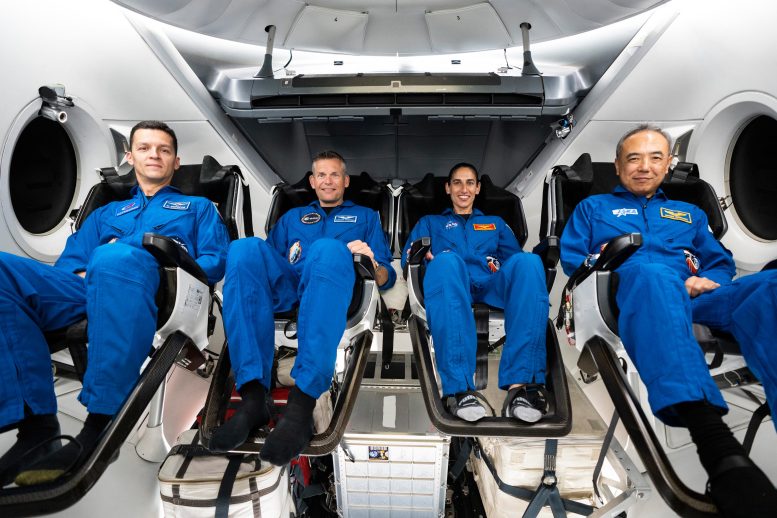
This is SpaceX Crew-7 with all four crewmembers sitting in the Crew Dragon Endurance that will fly them to the International Space Station. From left to right it is Konstantin Borisov from Roscosmos, Andreas Mogensen from ESA, Jasmin Moghbeli from NASA and Satoshi Furukawa from JAXA. Credit: SpaceX
NASA’s SpaceX Crew-7 mission is set to launch a diverse team of astronauts to the International Space Station to perform research and maintenance activities. They will monitor various spacecraft arrivals, conduct critical research, and after mission completion, return to Earth, where they’ll be retrieved by a SpaceX vessel off Florida’s coast.
A new cadre of four crew members is preparing to launch to the International Space Station as part of NASA’s SpaceX Crew-7 mission.
NASA astronaut Jasmin Moghbeli, ESA (European Space Agency) astronaut Andreas Mogensen, JAXA (Japan Aerospace Exploration Agency) astronaut Satoshi Furukawa, and Konstantin Borisov of Roscosmos will lift off from Launch Complex 39A at NASA’s Kennedy Space Center in Florida to perform research technology demonstrations, and maintenance activities aboard the microgravity laboratory.
The flight is the seventh crew rotation mission with SpaceX to station, and the eighth human spaceflight as part of NASA’s Commercial Crew Program. The international crew will fly aboard the SpaceX Dragon spacecraft, named Endurance, which previously flew NASA’s Crew-3 and Crew-5 missions.
As teams progress through Dragon milestones for Crew-7, they also are preparing a first-flight Falcon 9 booster for the mission. Once all rocket and spacecraft system checkouts are complete and all components are certified for flight, teams will mate Dragon to the Falcon 9 rocket in SpaceX’s hangar at the launch site. The integrated spacecraft and rocket will then be rolled to the pad and raised to vertical for a dry dress rehearsal with the crew and an integrated static fire test prior to launch.
Leaders from NASA, SpaceX, ESA (European Space Agency), and JAXA (Japan Aerospace Exploration Agency) presented an overview of NASA’s SpaceX Crew-7 mission to the International Space Station on July 25, 2023. The mission will carry NASA astronaut Jasmin Moghbeli, ESA astronaut Andreas Mogensen, JAXA astronaut Satoshi Furukawa, and Konstantin Borisov of Roscosmos to the International Space Station. A SpaceX Falcon 9 rocket and Dragon spacecraft will launch from Launch Complex 39A at NASA’s Kennedy Space Center in Florida on the company’s seventh crew rotation mission for NASA. Launch is scheduled for no earlier than Tuesday, August 15. Credit: NASA
The Crew
This will be Moghbeli’s first trip into space after being selected as a NASA astronaut in 2017. The New York native earned a bachelor’s degree in aerospace engineering with information technology at the Massachusetts Institute of Technology in Cambridge, Massachusetts, and a master of science in aerospace engineering from the Naval Postgraduate School in Monterey, California. Moghbeli, a helicopter and Marine Corps test pilot, has more than 150 combat missions and 2,000 hours of flight time in over 25 different aircraft. She is also a graduate of the U.S. Naval Test Pilot School in Patuxent River, Maryland. As mission commander, she will be responsible for all phases of flight, from launch to re-entry. She will serve as an Expedition 69/70 flight engineer aboard the station. Follow @astrojaws on Twitter.
Mogensen was selected as an ESA astronaut in 2009 and became the first Danish citizen in space after launching aboard a Soyuz for a 10-day mission to the space station in 2015. As the pilot on Crew-7, he will be responsible for spacecraft systems and performance. Aboard the station, he will serve as an Expedition 69/70 flight engineer.
Mogensen is from Copenhagen, Denmark. He completed undergraduate studies and received a master’s degree in aeronautical engineering from Imperial College London in England before gaining his doctorate in aerospace engineering from the University of Texas at Austin. Mogensen has since served as a crew member for NEEMO (NASA Extreme Environment Mission Operations) missions 17 and 19. Mogensen was the European astronaut liaison officer to NASA’s Johnson Space Center from 2016-2022, working as a CAPCOM for astronauts aboard the station and as ground support for spacewalks, relaying tasks and direction from mission control to the spacewalkers. Follow @astro_andreas on Twitter.
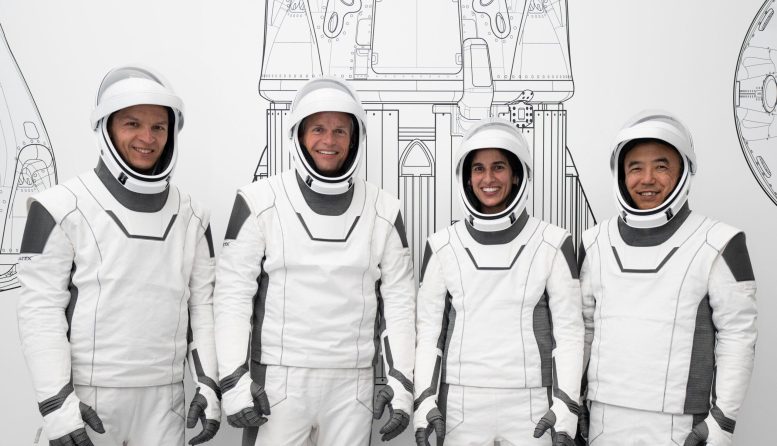
The four crew members who comprise the SpaceX Crew-7 mission pose for a photo in their spacesuits during a training session at the company’s headquarters in Hawthorne, California. From left are, Mission Specialist Konstantin Borisov, Pilot Andreas Mogensen, Commander Jasmin Moghbeli,, and Mission Specialist Satoshi Furukawa. Credit: SpaceX
Furukawa will be making his second trip to space, having spent 165 days aboard the space station as part of Expeditions 28 and 29 in 2011. Furukawa is from Kanagawa, Japan, and was selected as a JAXA astronaut in 1999. He is a physician and received his medical degree from the University of Tokyo, and later a doctorate in medical science from the same university. Furukawa served as a crewmember on the 13th NEEMO mission, and later, was appointed head of JAXA’s Space Biomedical Research Group. Aboard the station, he will become a flight engineer for Expedition 69/70. Follow @astro_satoshi on Twitter.
Borisov will be making his first trip to space, and will also serve as a mission specialist, working to monitor the spacecraft during the dynamic launch and entry phases of flight. He entered the Roscosmos Cosmonaut Corps as a test cosmonaut candidate in 2018 and will serve as a flight engineer for Expedition 69/70.
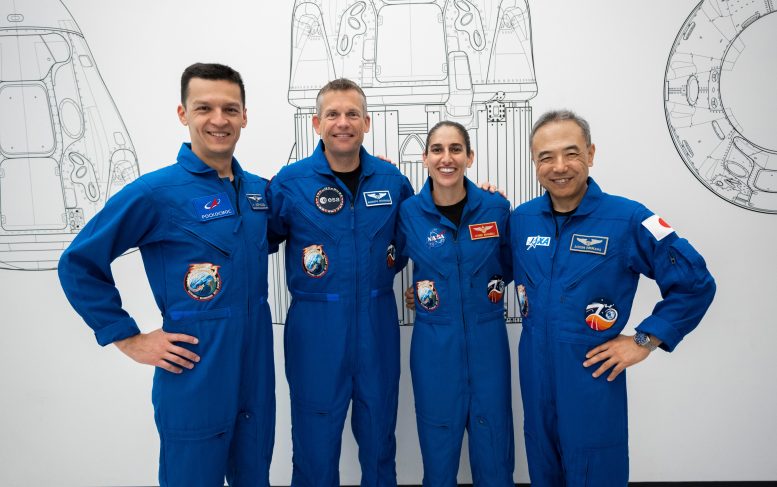
NASA’s SpaceX Crew-7 crew in training at SpaceX in Hawthorne, California, before their mission to the International Space Station. Credit: SpaceX
Mission Overview
Lifting off from Launch Pad 39A on a Falcon 9 rocket, Dragon will accelerate to approximately 17,500 mph, in order to intercept with the space station.
Once in orbit, the crew and SpaceX mission control in Hawthorne, California, will monitor a series of automatic maneuvers that will guide Endurance to the space-facing port of the station’s Harmony module. After several maneuvers to gradually raise its orbit, Dragon will be in position to rendezvous and dock with its new home in orbit. The spacecraft is designed to dock autonomously, but the crew can take control and pilot manually, if necessary.
After docking, Crew-7 will be welcomed inside the station by the seven-member crew of Expedition 69, and conduct several days of handover activities with the departing astronauts of NASA’s SpaceX Crew-6 mission. After the handover period, NASA astronauts Stephen Bowen and Woody Hoburg, along with UAE (United Arab Emirates) astronaut Sultan Alneyadi, and Roscosmos cosmonaut Andrey Fedyaev of Crew-6 will undock from the space station and splash down off the coast of Florida.
Crew-7 will conduct new scientific research to prepare for human exploration beyond low Earth orbit and benefit humanity on Earth. Experiments will include the collection of microbial samples from the exterior of the space station, the first study of human response to different spaceflight durations, and an investigation of the physiological aspects of astronauts’ sleep. These are just a few of the more than 200 science experiments and technology demonstrations that will take place during their mission.
While aboard the orbiting laboratory, Crew-7 will see the arrival of both the SpaceX Dragon and the Roscosmos Progress cargo spacecraft. Crew-7 also is expected to welcome the agency’s Boeing Crew Flight Test astronauts, the Axiom Mission-3 crew, and the first cargo flight of Sierra Space’s Dream Chaser during their expedition. The Soyuz spacecraft with three new crew members also is planned for launch during their stay, and the Soyuz carrying NASA astronaut Frank Rubio and Roscosmos cosmonauts Sergey Prokopyev and Dmitri Petelin will depart after 371 days on the station.
After completing a short handover with Crew-8 at the completion of the mission, Dragon with the four crew members aboard will autonomously undock, depart the space station and re-enter Earth’s atmosphere. After splashdown just off Florida’s coast, a SpaceX recovery vessel will pick up the spacecraft and the crew, who then will be helicoptered back to shore.
Commercial crew missions enable NASA to maximize use of the space station, where astronauts have lived and worked continuously for more than 22 years testing technologies, performing research, and developing the skills needed to operate future commercial destinations in low Earth orbit, and explore farther from Earth. Research conducted on the space station provides benefits for people on Earth and paves the way for future long-duration trips to the Moon and beyond through NASA’s Artemis missions.


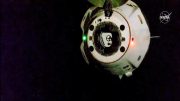


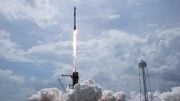
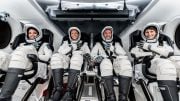
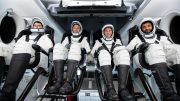
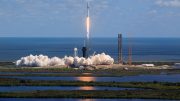
Be the first to comment on "NASA’s SpaceX Crew-7 Mission: What You Need To Know"